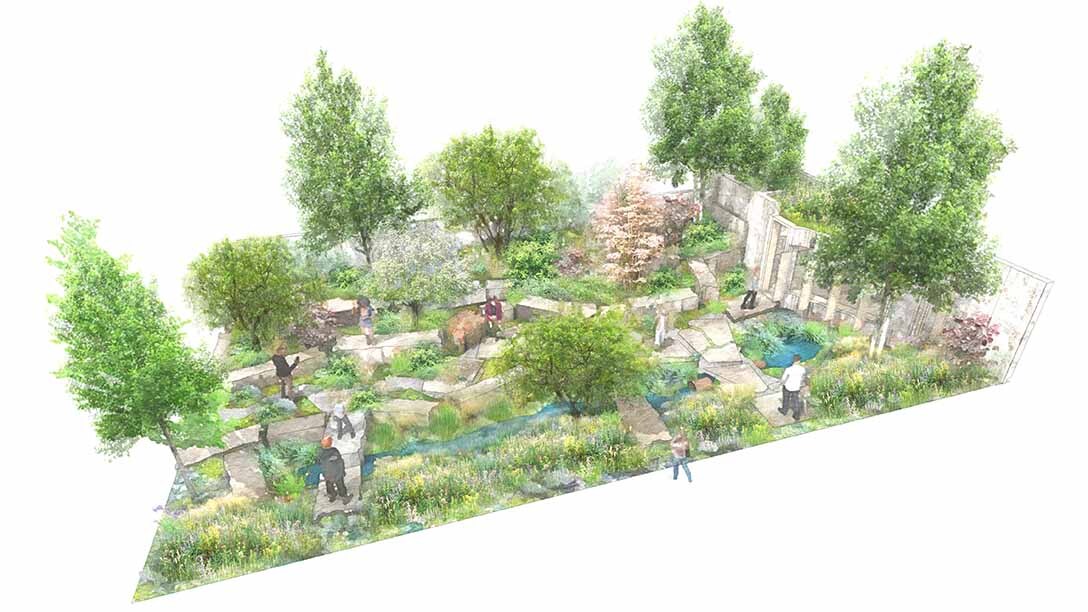Have you ever joyously stepped out to your backyard garden, freshly brewed coffee in hand, only to find your meticulously cared-for plants and herbs wilted and dying? Was the soil too dry? Did pests find their way in? During times like these, some frustrated gardeners may wish their fickle ficus would just tell them what it needs. A new Microsoft-partnered project in the UK is trying to see if that concept can be demonstrated in the real-word.
Next year, the Royal Horticultural Society in England will show off an “intelligent garden” that uses an AI model to monitor the garden’s environment and inform gardeners when it needs care. Visitors can ask the AI-powered garden questions. The model could then respond with phrases like “I need a bit more water,” or “I could use a haircut” depending on data captured in the soil. Aside from the pleasant novelty of chatting with plants, the garden will provide visitors with a physical representation of the many ways AI and Internet of Things technologies could be used to enhance sustainability and conservation efforts moving forward.
How the AI Garden works
The technical components of the garden are the product of a partnership between AI start-up Avande and Microsoft. When it is unveiled, the garden will rely on a network of sensors nestled throughout the garden measuring environmental factors like soil moisture, alkalinity, and nutrient levels as well as wind and projected rainfall. All of that data is then sent to a specially designed AI model housed in a pavilion at the back of the garden. The model, powered by Microsoft’s Azure Open AI Service, can then analyze those factors and inform gardeners on optimal feeding, watering, or trimming regiments.
Onsite plant caretakers aren’t the only ones who can interact with the garden. Visitors to the Chelsea Flower Show will be able to walk up to virtual platforms and ask the intelligence garden questions about its current environmental state. The AI language module will then interpret the data and spit it back out to the visitors in a coherent, conversational dialogue. In theory, insights provided by models like this one could help gardeners allocate resources efficiently and avoid over-watering plants before rainfall, both of which can aid in sustainability efforts. Those tools could be a welcome convenience for casual growers or businesses looking to trim utility costs. It’s unclear, however, whether even the best models can account for anomalies and individual plant tendencies with the same level of care as experienced gardeners.
Tom Massey, one of the garden’s two designers, described the project as a “unique opportunity to address some of horticulture’s most challenging environmental issues.”
“I am excited to see how AI can assist gardeners to help make a meaningful impact that will help us all garden and grow more sustainably,” Massey said in a press release.

AI-assisted, not AI designed
Massey and fellow designer Je Ahn wanted to avoid falling into the trap of making the AI garen feel overly artificial. Though sensors and algorithms play a critical role in maintaining the plants, the actual physical design of the space was left up to humans. The result is a “forest garden concept” lush with biodiversity and greenery. Once the exhibit concludes, the garden will reportedly live on as an accessible community space.
“AI hasn’t designed the garden, AI is assisting the gardeners looking after it,” Massey said in an interview with The Independent.
Though AI chatbots and image generators tend to attract the most attention, more traditional AI models are already playing an important role in agriculture for resource management and sustainability. Farmers in the US are already using AI to measure soil health to improve crop yields and protect against drought in a practice referred to as “precision agriculture.” Everyday gardeners have already gotten in on the practice. Gardeners are reportedly using ChatGPT and other chatbots to ask questions about water or feeding requirements for certain plants, despite the fact that these models are still prone to hallucinating false claims. Several currently available apps also use AI to help garners identify unknown plants by comparing a photo of them against a large online database. But as past reporting has shown, simply trusting an AI to tell you whether a plant or fungi of unknown origin is safe to eat isn’t wise, and could have dangerous results.

